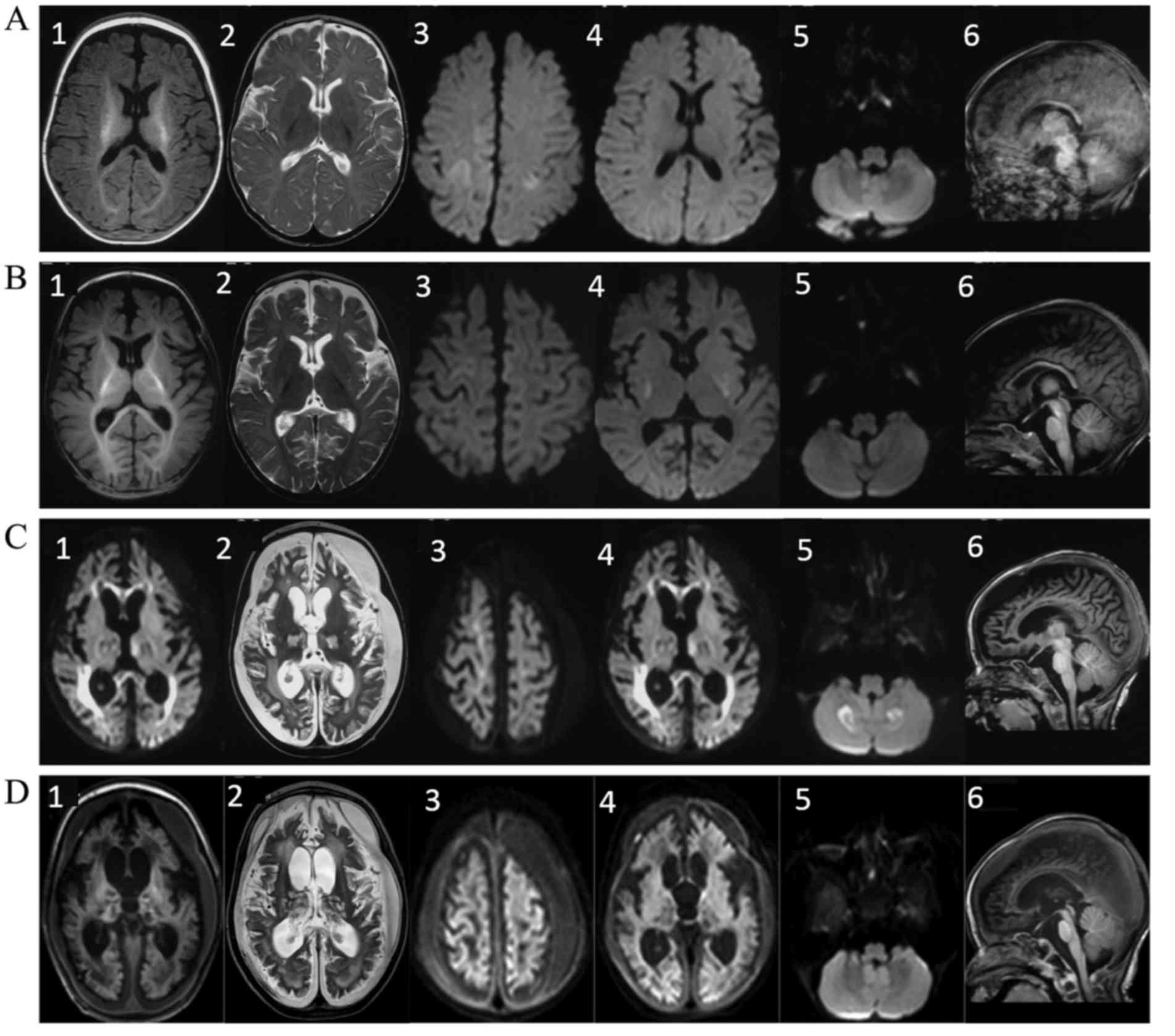|
1
|
Glamuzina E, Brown R, Hogarth K, Saunders
D, Russell-Eggitt I, Pitt M, de Sousa C, Rahman S, Brown G and
Grunewald S: Further delineation of pontocerebellar hypoplasia type
due to mutations in the gene encoding mitochondrial arginyl-tRNA
synthetase, RARS. J Inherit Metab Dis. 35:459–467. 2012. View Article : Google Scholar : PubMed/NCBI
|
|
2
|
Edvardson S, Shaag A, Kolesnikova O,
Gomori JM, Tarassov I, Einbinder T, Saada A and Elpeleg O:
Deleterious mutation in the mitochondrial arginyl-transfer RNA
synthetase gene is associated with pontocerebellar hypoplasia. Am J
Hum Genet. 81:857–862. 2007. View
Article : Google Scholar : PubMed/NCBI
|
|
3
|
Rankin J, Brown R, Dobyns WB, Harington J,
Patel J, Quinn M and Brown G: Pontocerebellar hypoplasia type: A
British case with PEHO-like features. Am J Med Genet A.
152A:2079–2084. 2010. View Article : Google Scholar : PubMed/NCBI
|
|
4
|
Namavar Y, Barth PG, Kasher PR, van
Ruissen F, Brockmann K, Bernert G, Writzl K, Ventura K, Cheng EY,
Ferriero DM, et al: Clinical, neuroradiological and genetic
findings in pontocerebellar hypoplasia. Brain. 134:143–156. 2011.
View Article : Google Scholar : PubMed/NCBI
|
|
5
|
Kastrissianakis K, Anand G, Quaghebeur G,
Price S, Prabhakar P, Marinova J, Brown G and McShane T: Subdural
effusions and lack of early pontocerebellar hypoplasia in siblings
with RARS mutations. Arch Dis Child. 98:1004–1007. 2013. View Article : Google Scholar : PubMed/NCBI
|
|
6
|
Cassandrini D, Cilio MR, Bianchi M, Doimo
M, Balestri M, Tessa A, Rizza T, Sartori G, Meschini MC, Nesti C,
et al: Pontocerebellar hypoplasia type 6 caused by mutations in
RARS2: Definition of the clinical spectrum and molecular findings
in five patients. J Inherit Metab Dis. 36:43–53. 2013. View Article : Google Scholar : PubMed/NCBI
|
|
7
|
Lax NZ, Alston CL, Schon K, Park SM,
Krishnakumar D, He L, Falkous G, Ogilvy-Stuart A, Lees C, King RH,
et al: Neuropathologic characterization of pontocerebellar
hypoplasia type 6 associated with cardiomyopathy and hydrops
fetalis and severe multisystem respiratory chain deficiency due to
novel RARS2 mutations. J Neuropathol Exp Neurol. 74:688–703. 2015.
View Article : Google Scholar : PubMed/NCBI
|
|
8
|
Li Z, Schonberg R, Guidugli L, Johnson AK,
Arnovitz S, Yang S, Scafidi J, Summar ML, Vezina G, Das S, et al: A
novel mutation in the promoter of RARS2 causes pontocerebellar
hypoplasia in two siblings. J Hum Genet. 60:363–369. 2015.
View Article : Google Scholar : PubMed/NCBI
|
|
9
|
Nishri D, Goldberg-Stern H, Noyman I,
Blumkin L, Kivity S, Saitsu H, Nakashima M, Matsumoto N,
Leshinsky-Silver E, Lerman-Sagie T and Lev D: RARS2 mutations cause
early onset epileptic encephalopathy without ponto-cerebellar
ypoplasia. Eur J Paediatr Neurol. 20:412–417. 2016. View Article : Google Scholar : PubMed/NCBI
|
|
10
|
Lühl S, Bode H, Schlötzer W, Bartsakoulia
M, Horvath R, Abicht A, Stenzel M, Kirschner J and Grünert SC:
Novel homozygous RARS mutation in two siblings without
pontocerebellar hypoplasia-further expansion of the phenotypic
spectrum. Orphanet J Rare Dis.
|
|
11
|
Ngoh A, Bras J, Guerreiro R, Meyer E,
McTague A, Dawson E, Mankad K, Gunny R, Clayton R, Mills PB, et al:
RARS2 mutations in a sibship with infantile spasms. Epilepsia.
57:e97–e102. 2016. View Article : Google Scholar : PubMed/NCBI
|
|
12
|
Li H and Durbin R: Fast and accurate
long-read alignment with Burrows-Wheeler transform. Bioinforma.
26:589–595. 2010. View Article : Google Scholar
|
|
13
|
McKenna A, Hanna M, Banks E, Sivachenko A,
Cibulskis K, Kernytsky A, Garimella K, Altshuler D, Gabriel S, Daly
M and DePristo MA: The Genome Analysis Toolkit: A MapReduce
framework for analyzing next-generation DNA sequencing data. Genome
Res. 20:1297–1303. 2010. View Article : Google Scholar : PubMed/NCBI
|
|
14
|
Wang K, Li M and Hakonarson H: ANNOVAR:
Functional annotation of genetic variants from high-throughput
sequencing data. Nucleic Acids Res. 38:e1642010. View Article : Google Scholar : PubMed/NCBI
|
|
15
|
Lek M, Karczewski KJ, Minikel EV, Samocha
KE, Banks E, Fennell T, O'Donnell-Luria AH, Ware JS, Hill AJ,
Cummings BB, et al: Analysis of protein-coding genetic variation in
60,706 humans. Nature. 536:285–291. 2016. View Article : Google Scholar : PubMed/NCBI
|
|
16
|
Richards S, Aziz N, Bale S, Bick D, Das S,
Gastier-Foster J, Grody WW, Hegde M, Lyon E, Spector E, et al:
Standards and guidelines for the interpretation of sequence
variants: A joint consensus recommendation of the American College
of Medical Genetics and Genomics and the Association for Molecular
Pathology. Genet Med. 17:405–424. 2015. View Article : Google Scholar : PubMed/NCBI
|















